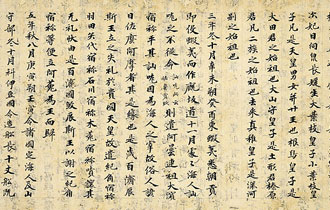Pages |
Futabatei began writing his work, Ukigumo (The Drifting Cloud, 1887-1889), with the intention of rendering the spoken form of the upper class Tokyo dialect into written form. In the first section of his three-part novel, Futabatei was unable, for the most part, to put aside his classical training and use the colloquial style. However, by the time he reached the third section of his novel two years later, he had decided on the colloquial verb ending and had purged much of the classical vocabulary from his writing. His work received high praise from fellow writers and literature specialists of the time. Today, scholars such as Marleigh Grayer Ryan consider Ukigumo Japan's first modern novel. While the problem of the genbun'itchi style had not yet been resolved, Futabatei had produced a prototype. Other writers such as Yamada Bimyō (1868-1910), Mori Ōgai (1862-1922), Saganoya Omuro (1863-1947), among others, would use this form of Japanese that was more closely aligned with the actual use of language.
The futsūbun (ordinary language) movement was initiated, in large part, in reaction to the radical reform of the genbun'itchi advocates. As more and more language reform activists embraced the idea of reforming Japanese, it became clear to more moderate elements that the Japanese language was inevitably going to undergo some sort of change. One of the primary advocates of futsūbun was Ochiai Naobumi (1861-1903). Naobumi was a well-known poet, a professor at Tōkyō Senmon Gakkō (the institution which would later become Waseda University) and editor of several literary journals. He embraced the traditional arts in Japan--especially the language. But he too could recognize that language reform was imminent and wanted to take part in the process. Naobumi sought a "middle way," one that retained the traditions of the classical forms but which would be more accessible for those Japanese with a rudimentary education. Speaking later on this, Donald Keene, the preeminent English-language scholar of Japanese literature, wrote that Naobumi's orthodox training in the Japanese classics prevented him from breaking completely with tradition.
Naobumi was an active member of the Nihon bunshōkai, a group dedicated to the advancement of traditional Japanese writing. He, along with several other textbooks authors who were members of this organization, assembled with the express purpose of creating a written language that could be used in primary and middle school textbooks. They decided ultimately that futsūbun was to be a modernized version of classical Japanese (wabun) with a significant percentage of vocabulary coming from kanbun. They began to write textbooks using this form and cornered the market for several years. The futsūbun version of Japanese became, for approximately fifteen years, the language used in the majority of primary school textbooks and newspapers in Meiji Japan. In this way, futsūbun began to replace the classical forms of the written language and emerged to become the dominant form of written Japanese during the last years of the nineteenth century.
In March of 1900, the Imperial Society for Education (Japan's premier educational lobbying organization) launched the Genbun'itchi Society for the purposes of promoting the colloquial style in fields other than literature. They were convinced that even futsūbun, the classical standard agreed upon by a consensus of intellectuals and linguists in the early 1890s, needed to be abandoned. In the Society's official records, the goals of the organization can be found. First, the members were to decide on a standard language. Second, they were to help diffuse the genbun'itchi form by writing contributions to newspapers and magazines using the colloquial style. Third, they were to write using the colloquial style in all correspondence.
Pages |











